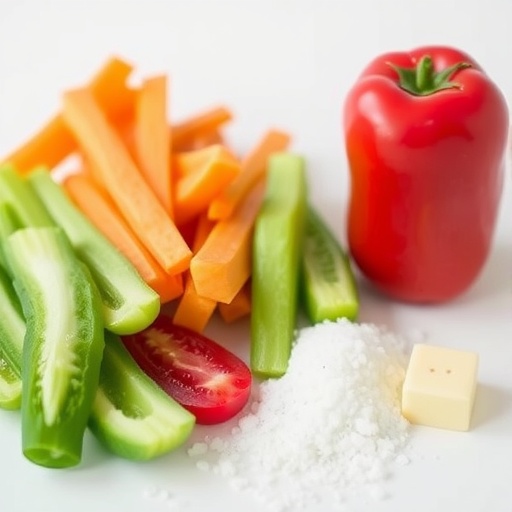In a striking revelation unveiled at the American Heart Association’s Hypertension Scientific Sessions 2025, new data demonstrate that despite the proven efficacy of salt substitutes in reducing sodium intake and controlling high blood pressure, their adoption among Americans with hypertension remains surprisingly minimal. This comprehensive analysis, spanning nearly two decades of nationally representative survey data, sheds light on a largely overlooked but pivotal public health opportunity to combat cardiovascular disease through a simple dietary intervention.
High blood pressure, a condition affecting nearly half of American adults, poses significant risks including heart attacks, strokes, and kidney disease. Its relationship with dietary sodium intake has long been established, with excessive sodium consumption directly exacerbating blood pressure levels. Potassium, conversely, plays a vital antagonistic role, helping to relax blood vessels and excrete sodium through urine, thereby lowering blood pressure. Salt substitutes, which partially or fully replace sodium chloride with potassium salts, offer a strategic means to leverage this physiological mechanism. However, usage rates of these alternatives remain astonishingly low.
This groundbreaking study utilized data from the National Health and Nutrition Examination Survey (NHANES), covering the years 2003 through early 2020, to track salt substitute usage patterns among U.S. adults. Researchers meticulously categorized participants based on blood pressure status and treatment regimens, delineating groups with treated and controlled hypertension, treated but uncontrolled hypertension, untreated hypertension, and normotensive individuals. They further refined analysis to identify those medically eligible for potassium-enriched salt substitutes, explicitly excluding individuals with chronic kidney conditions or those on medications heightening the risk of hyperkalemia, the potentially dangerous elevation of blood potassium levels.
Findings revealed that throughout the survey period, salt substitute usage collectively remained below 6%, with a peak at 5.4% during 2013-2014 before declining to approximately 2.5% by early 2020. Even among individuals with high blood pressure, known to benefit most from sodium reduction strategies, adoption was modest at best. Those whose hypertension was managed successfully through medications exhibited only 3.6% to 10.5% use, while those with uncontrolled hypertension despite pharmacological intervention were only marginally more likely to use substitutes, with rates between 3.7% and 7.4%.
Perhaps most surprising was the negligible use among those with untreated hypertension and individuals with normal blood pressure, both groups consistently registering below 5.6% uptake. This persistence of low salt substitute utilization underscores an urgent need for heightened clinical awareness and public health initiatives aimed at educating both patients and healthcare providers about the potential advantages and safe practices surrounding salt substitutes.
The research team, led by Yinying Wei of UT Southwestern Medical Center, highlighted that while salt substitutes are economically accessible and scientifically validated as a tool to manage blood pressure, their bitter aftertaste when heated—due to potassium salts—and limited public and clinical knowledge may pose barriers. The prevalent consumption of processed and restaurant-prepared foods, which are major contributors to sodium intake, adds complexity to reducing overall sodium exposure through home-use salt substitutes alone.
An additional noteworthy observation was the apparent correlation between frequent dining out and lower salt substitute use, potentially reflecting the uncontrolled sodium levels in commercial food settings. However, once demographic and socioeconomic factors such as age, race, education, and insurance status were factored in, this association lost statistical significance, suggesting that dietary habits and accessibility may intertwine with broader social determinants of health.
The study does acknowledge limitations intrinsic to self-reported data, including possible underestimation or misclassification of salt substitute use and the inability to distinguish specifically between potassium-enriched substitutes and other salt alternatives. Importantly, detailed quantification of the amount of salt substitute consumed was unattainable from the survey data, representing an area ripe for future research to better gauge dosage effects on health outcomes.
Experts unconnected to the study, such as Dr. Amit Khera from UT Southwestern Medical Center, emphasized that these findings represent a deeply concerning missed opportunity. The persistent underutilization of salt substitutes, especially among populations with treatment-resistant hypertension, calls for concerted efforts to integrate simple nutritional strategies into standard hypertension management protocols.
Moving forward, research must delve into the multifaceted barriers limiting salt substitute uptake, which likely span sensory preferences, cost concerns, lack of awareness among both consumers and clinicians, and possible misconceptions regarding safety. Tailored interventions addressing these impediments could unlock a widespread, low-cost method to enhance blood pressure control nationwide, potentially averting thousands of related cardiovascular events annually.
Given the high societal and economic burden of hypertension and its sequelae, this preliminary but compelling evidence prompts urgent calls for advocacy, education, and policy reforms to promote the safe adoption of potassium-enriched salt substitutes. Health practitioners are urged to initiate informed dialogues with their patients about incorporating these alternatives where medically appropriate, customized to individual risk profiles, especially given the critical warning for those with kidney disease or on potassium-altering medications.
In summary, this extensive analysis underscores that, despite unequivocal nutritional chemistry and physiological rationale supporting salt substitutes as a cornerstone for blood pressure management, American adults have largely neglected this option. Elevating awareness and accessibility of salt substitutes may represent one of the most straightforward yet underexploited interventions within cardiovascular public health strategies.
By harnessing the full potential of salt substitutes and embedding them into multifaceted hypertension treatment plans, clinicians, researchers, and policy makers can make significant strides toward reducing the staggering morbidity and mortality attributable to uncontrolled high blood pressure in the United States and beyond.
Subject of Research: Utilization patterns and trends of salt substitutes among U.S. adults with high blood pressure, emphasizing potassium-enriched salt alternatives and implications for hypertension management.
Article Title: Low Adoption of Salt Substitutes Among Americans with Hypertension Revealed in Long-Term National Survey
News Publication Date: September 4, 2025
Web References:
- https://professional.heart.org/en/meetings/hypertension
- https://www.heart.org/en/health-topics/high-blood-pressure
- https://newsroom.heart.org/news/u-s-survey-finds-salt-substitutes-rarely-used-by-people-with-high-blood-pressure?preview=c9618d93e3f54d7ac9ffbc5bd71f1376
Keywords: Hypertension, Salt substitute, Potassium salt, Blood pressure management, Sodium reduction, Cardiovascular disease, Public health, Nutrition, NHANES, Potassium, Hyperkalemia, Dietary intervention




